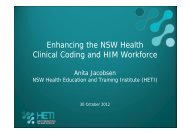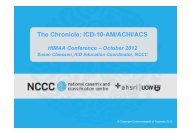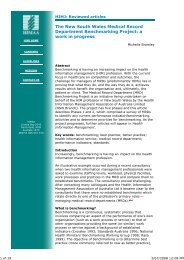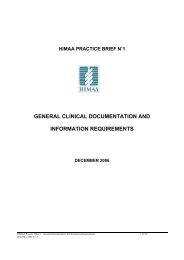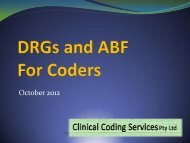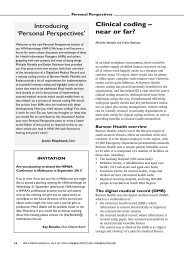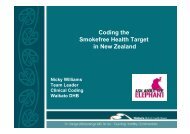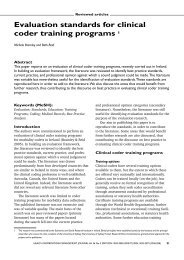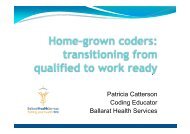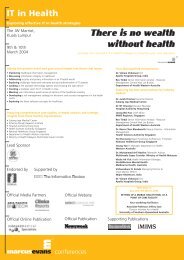Health Information Management Journal Guidelines for authors
Health Information Management Journal Guidelines for authors
Health Information Management Journal Guidelines for authors
You also want an ePaper? Increase the reach of your titles
YUMPU automatically turns print PDFs into web optimized ePapers that Google loves.
the author or <strong>authors</strong>. An acceptable length <strong>for</strong> reports is between 1500and 5000 words.• Conference Reports. The <strong>Journal</strong> invites those who have attended anyconference of particular interest to the <strong>Journal</strong>’s readership to submit ashort overview and critique of the conference proceedings.• Reviews. Reviews of software, hardware, books and other media ofinterest and relevance to health in<strong>for</strong>mation managers and relatedprofessionals are encouraged. Articles in these categories are typicallybetween 200 and 500 words in length.• Case Studies.• Sounding Board. Articles of approximately 1,000 words which initiate orcontribute to the debate on new and evolving issues and ideas appear inthis section.• Letters to the Editor. Letters on any topic of relevance and interest toprofessionals interested in health in<strong>for</strong>mation management andin<strong>for</strong>matics are welcome. Letters should not exceed 300 words in length.Professional decorum should be observed; letters are published at theEditor’s discretion.• Professional profiles. This section is intended to demonstrate the depthand breadth of professional work roles of individual <strong>Health</strong> <strong>In<strong>for</strong>mation</strong>Managers, including recent graduates, through personal accounts ofworkplace experiences.Please note: it is not the policy of the Editorial Board to publish materials intended <strong>for</strong>commercial purposesGeneral in<strong>for</strong>mation concerning all articlesStyleAuthors should aim to use simple, direct and correct English, and spelling shouldcon<strong>for</strong>m with the third edition of the Macquarie Dictionary. <strong>Health</strong> <strong>In<strong>for</strong>mation</strong><strong>Management</strong> <strong>Journal</strong> con<strong>for</strong>ms with the Harvard (Author-Date) referencing style.For details, please refer to the Style Manual <strong>for</strong> Authors, Editors and Printers.Revised by Snooks & Co. (6 th edition), 2002. Milton, QLD: John Wiley & Sons. Inaddition the following website is a valuable resource: go tohttp://www.latrobe.edu.au/bendigo/about/assignment_manual.html then click on‘Harvard (Author-Date) System’.Headings and subheadingsClear distinctions should be made between headings and subheadings.Tables and figuresTables, figures and other graphics are to be submitted on separate pages at theend of the document, and not embedded in the text. The body of the text is toinclude notations about placement of tables, figures or graphics by leaving four
lines of space and making a note ‘Insert table/figure/graphic x here’. Tables,figures and graphics should be clearly identified by consecutive numbering usingarabic numerals and by providing concise titles <strong>for</strong> all figures used. A legend <strong>for</strong>each table and figure should be included.ReferencesTitles of journals must be written in full; e.g., Medical <strong>Journal</strong> of Australia, notMJA. References should be listed in alphabetical order at the end of the paper,using the Harvard <strong>for</strong>mat <strong>for</strong> sequence of details and <strong>for</strong> punctuation.Acknowledgments.Acknowledgments may include significant contributions made in the support ofthe study or, in writing the manuscript. Permission should be obtained from anyindividuals named in the acknowledgments. (Be aware that people beingidentified may need to give their permission, since inclusion of names may inferpotentially unwarranted endorsement of the paper’s conclusions). Copies ofpermission statements should be submitted with the manuscript.CopyrightManuscripts submitted to <strong>Health</strong> <strong>In<strong>for</strong>mation</strong> <strong>Management</strong> should not have beenpublished elsewhere, nor to have been offered, or be under consideration by anyother journal or publisher in any medium. Inclusion in conference proceedings(apart from abstracts) is considered as prior publication.Upon acceptance <strong>for</strong> publication, <strong>authors</strong> are requested to assign copyright tothe <strong>Health</strong> <strong>In<strong>for</strong>mation</strong> <strong>Management</strong> Association of Australia Limited (HIMAA) atthe Editor’s discretion. It should be noted that acceptance <strong>for</strong> publication doesnot imply endorsement of <strong>authors</strong>' opinions by the HIMAA or the Editorial Board.Contributing <strong>authors</strong> are protected by the Copyright Act 1968 (Commonwealth ofAustralia). To view the Copyright Agreement, click here.Timelines and publicationFor most manuscripts allow a minimum of three months from initial submission toacceptance and publication. Successful <strong>authors</strong> are notified in writing when theirmanuscript has been accepted <strong>for</strong> publication. Where possible, a date <strong>for</strong>publication is specified at that time. In some cases, the editors reserve the rightto hold manuscripts over to future issues of the <strong>Journal</strong> <strong>for</strong> publication.Special guidelines <strong>for</strong> peer reviewed articlesArticles submitted <strong>for</strong> publication in this category are reviewed by twoindependent and impartial reviewers who are unaware of the author’s identity.Similarly, <strong>authors</strong> are not in<strong>for</strong>med of the identity of the reviewers. Allcommunication with reviewers is conducted via the editors. No direct contact ismade between reviewers and <strong>authors</strong>.
TextThe Editorial Board of <strong>Health</strong> <strong>In<strong>for</strong>mation</strong> <strong>Management</strong> <strong>Journal</strong> suggests theusual academic model of abstract, introduction, method, results, discussion andconclusion <strong>for</strong> most original articles. Substantial non-reviewed articles may alsofollow this model, or variations of it.• Abstract. Abstracts should be approximately 100 words in length, andsummarise the purpose, method, results, summary of key findings andconclusions of the paper.• Introduction. This should state the purpose of the paper. Normally,introductions include a short, relevant literature review, including pertinentbackground in<strong>for</strong>mation.• Method. includes selection of subjects (population and sample sizes, <strong>for</strong>example), mode of observation, apparatus and statistical procedures. Theaim of the method section is to provide enough in<strong>for</strong>mation to allowreplication of the procedures used in the original research. Reasons <strong>for</strong>selection of methods should also be included in this section.• Results should be presented logically, and can include text, tables,figures or other graphics. Do not duplicate data presented in tables withinthe text.• Discussion. Major, new and significant observations and findings shouldbe highlighted and discussed. The significance of results compared withsimilar previous studies is to be included. If a hypothesis was being tested,it is necessary to report whether the hypothesis was supported or rejected.The implications and limitations of the findings, along with their practicalimplementations, should be reported here. The significance of the study’sresults should be compared and contrasted with similar, previouslypublished in<strong>for</strong>mation in this section. It may be helpful to readers toaccurately sub-head the section to make clear differentiations between the‘discussion’ and the ‘literature review’.• Conclusion. The conclusion contains a brief summary of the majorfindings of the study, but is not a reiteration of the abstract. Statementswhich cannot be supported by the in<strong>for</strong>mation are not to be presented inthe manuscript. Do not include new in<strong>for</strong>mation, nor summarise themanuscript.• Footnotes. Footnotes may be used to elaborate a point, and in somecases to cite in<strong>for</strong>mation not normally included in the references at the endof the manuscript. Footnotes may, <strong>for</strong> example, provide further technicalin<strong>for</strong>mation about computer hardware or software used in a project, which,if included in the body of the text, is confusing to the reader. It is alsouseful <strong>for</strong> adding an aside, or valid comment apart from the text.Footnotes should be numerically identified by using superscript romannumerals in the text, with links at the bottom of the page on which thefootnote indicator appears.Submitting a manuscript <strong>for</strong> reviewAuthors should ensure that they adhere to the following guidelines:
• If possible, articles should contain no more than 5,000 words (this doesnot include footnotes, endnotes or references).• Type should be double-spaced, pages printed single-side only.• All pages of main text should be numbered.• Three hard copies are to be submitted; it is not necessary to provide anelectronic version at this stage.• Conventional photographs are discouraged because of download time;digital photographs are preferred. If they are essential, photographsaccompanying manuscripts should be clearly identified and captioned. Inaddition, the subject’s permission to publish may be required.• Formatting of the document should be kept to a minimum. Do not try toachieve a ‘typeset’ look as your <strong>for</strong>matting commands will be discardedduring final typesetting and may interfere with this process.• A <strong>for</strong>mal covering letter should be included with the manuscript.• Ensure that the manuscript includes the following on separate pages:o Title page. The title should indicate concisely the purpose of the paper.o Abstract, followed by four key words or key terms. Abstracts should beapproximately 100 words in length, and cover the purpose, method,results, summary of key findings and conclusions. Key words andterms should be selected from the Index Medicus Medical SubjectHeadings list (MeSH): http://www.nlm.nih.gov/mesh/MBrowser.htmlo Author identification page. Details on this page should include:• Author(s) given names and family name (in bold print), followedby appropriately abbreviated academic qualifications andawards, institutional affiliations and positions and other relevantin<strong>for</strong>mation.• For manuscripts with multiple <strong>authors</strong>, the author to whomcorrespondence is to be directed should be identified.• Contact details: telephone numbers and email and postaladdresses are to be included, and if the manuscript is submittedby more than one author the lead author should be identified.o Acknowledgements. Acknowledgments of sources of funding <strong>for</strong>research projects should be included here. Please note that thisin<strong>for</strong>mation will be published.Contributors checklist <strong>for</strong> refereed papersPlease ensure that you have:Included a covering letter with the manuscriptIncluded three hard copies of the manuscriptNominated an author to receive correspondenceStarted each section of the manuscript on a new pageDouble spaced the textPrinted one side of the paper onlyNumbered all pages of main textChecked all pages have been included
Included biographical details <strong>for</strong> each authorAsked someone not involved in writing the manuscript to proof read itChecked all referencingIncluded all necessary acknowledgementsIncluded all necessary permission statementsIncluded a 100-word abstractIncluded four key words or terms (selected from MeSH)Provided captions <strong>for</strong> photographs, tables, figures and graphsCommenced all tables, figures and graphics on a new pageRemoved all jargonExpressed all acronyms and abbreviations in full at their first iterationChecked all diagrams and tables are clearly labelledSpecial guidelines <strong>for</strong> non-reviewed articlesContributions such as reports, letters and other short communications which donot present original research are not usually reviewed; they are, however, subjectto editorial scrutiny. Such articles may be edited to improve the quality ofexpression and to comply with the <strong>Journal</strong>’s established style. Minor changes,including correcting spelling, grammar and typographical errors, will be madewithout consultation with <strong>authors</strong>.Submitting a non-reviewed manuscriptAuthors should ensure that they adhere to the following guidelines:• Reviews, reports etc. should have a maximum length 5,000 words; letters,300 words.• All pages of main text should be numbered.• Articles should be submitted electronically.• Conventional photographs are discouraged because of download time;digital photographs are preferred. Photographs should be clearly identifiedand captioned. In addition, the subject’s permission to publish may berequired.• Formatting of the document should be kept to a minimum. Do not try toachieve a ‘typeset’ look as your <strong>for</strong>matting commands will be discardedduring final typesetting and may interfere with this process.Authors should ensure that the manuscript includes the following details:• Title• If appropriate, an abstract, followed by four key words or key terms.Abstracts should be approximately 100 words in length, and summarisethe context, key outcomes, recommendations and conclusions drawn fromthe report. Key words and terms should be selected from the IndexMedicus Medical Subject Headings list (MeSH):http://www.nlm.nih.gov/mesh/MBrowser.html
• Author(s) given names and family name(s) (in bold print), followed byappropriately abbreviated academic qualifications and awards, institutionalaffiliations and positions and other relevant in<strong>for</strong>mation.• Corresponding author in the case of manuscripts with multiple <strong>authors</strong>.• Contact details: telephone numbers and email and postal addresses are tobe included, and if the manuscript is submitted by more than one authorthe lead author should be identified.• Acknowledgements. Acknowledgments of sources of funding <strong>for</strong> researchprojects should be included here. Please note that this in<strong>for</strong>mation will bepublished.Contributors checklist <strong>for</strong> non-refereed papersPlease ensure that you have:Nominated an author to receive correspondenceStarted each section of the manuscript on a new pageIncluded biographical details <strong>for</strong> each contributorAsked someone not involved in writing the manuscript to proof read itChecked all referencingIncluded all necessary acknowledgementsIncluded all necessary permission statementsIf appropriate, included a 100-word abstractIf appropriate, Included four key words or terms (selected from MeSH)Provided captions <strong>for</strong> photographs, tables, figures and graphsCommenced all tables, figures and graphics on a new pageRemoved all jargonExpressed all acronyms and abbreviations in full at their first iterationChecked all diagrams and tables are clearly labelledSubmitting your manuscriptPlease <strong>for</strong>ward manuscripts toThe Editor, <strong>Health</strong> <strong>In<strong>for</strong>mation</strong> <strong>Management</strong> <strong>Journal</strong>School of Public <strong>Health</strong>La Trobe UniversityBundoora, Victoria 3086AustraliaTel: (03) 9479 1750Email: K.Robinson@latrobe.edu.au© 2003 <strong>Health</strong> <strong>In<strong>for</strong>mation</strong> <strong>Management</strong> Association of Australia Limited



